Members: SWCDs
Soil and Water Conservation Districts (SWCDs) are special districts (local government organizations) that were founded in response to the Dust Bowl in order to promote and assist in voluntary natural resource conservation, especially of agricultural and forestland. The Dust Bowl was a devastating natural disaster that was caused in part by lack of foresight in how changing agricultural practices affected soils. The result was astounding erosion and dust storms that harmed not only soil and water quality, but also the U.S. economy and food production system, and human health.
Today, Oregon’s SWCDs work on a wide range of projects in both urban and rural areas, and through a wide range of programs including outreach and education in addition to on-the-ground conservation work. SWCDs have paid managers, and sometimes staff, to do the day-to-day work of the District, and are governed by unpaid boards of directors. Most directors are elected, but there are also opportunities to volunteer as an associate director to participate in discussions and help inform the board. SWCD board meetings are public meetings, with opportunity for public comment. SWCDs are primarily funded by OWEB. In 2015-2017, OWEB provided the 45 SWCDs in Oregon with a total of $6.25 million in baseline funding. With these funds and funding obtained by applying for grants, the Districts:
- Assisted 8,690 landowners
- Implemented 66,930 acres of agricultural water quality projects, and approved plans on an additional 18,000 acres
- Provided educational events to approximately 70,000 people
How do I contact a Conservation District and where are they located?
The Importance of Conservation
Oregon has a total land area of 61.4 million acres, of which 75% is forested or in agricultural use. These lands provide the water resources, food and fiber that nourish our communities and economy. Forty percent of forest land is privately owned, increasingly by non-industrial forest landowners. Supporting and promoting voluntary conservation practices on private land is crucial to protecting and enhancing soil quality, habitat, and water quality and quantity. SWCDs work closely with private landowners and managers to help them achieve their stewardship goals and contribute to the natural resource goals of the surrounding community and state.
SWCDs also work with federal agencies to achieve watershed-scale benefits. More than half of Oregon’s land is owned and managed by the federal government, mainly under the control of the Forest Service and the Bureau of Land Management. Another 3 percent is owned by state and local governments.
The roots of SWCDs in the Dust Bowl are one reason why they have historically been focused on conservation in agricultural settings, supporting practices that benefit both natural resources and agricultural production. For instance, irrigation efficiency improvements are win-win solutions. Agriculture is the second-largest economic driver in Oregon, with diverse products that are economically linked to $50 billion of all Oregon sales and $22.9 billion of Oregon’s net state product. production of Christmas trees, grass seed, hazelnuts, peppermint, and a variety of caneberry crops. Other crops, such as hops, strawberries, prunes, plums, onions, cauliflower, pears and nursery stock, play an important role in Oregon’s economy.
Oregon has several distinct agricultural regions:
- The Willamette Valley is the most diversified, with over 200 specialty crops.
- Tree fruits, potatoes and livestock dominate Southern Oregon’s agricultural industry west of the Cascades.
- Commercial fishing and dairy farms are abundant on the Oregon Coast.
- Malheur County, adjacent to Idaho, produces seed crops, onions, potatoes, sugar beets, and other specialty crops.
- Livestock and hay production are the dominant agricultural enterprises in Harney and Lake Counties in Southeastern Oregon.
- Jefferson County and other Central Oregon areas grow a wide range of crops, including vegetable seeds, peppermint, and small grains in addition to pasture and hay production.
- North Central Oregon east of the Cascades along the Columbia River Gorge predominantly produces small grains.
- Crops in Klamath County include small grains, sugar beets, potatoes, pasture and hay.
Livestock grazing is a dominant land use throughout Oregon.
Oregon’s water resources are fundamental to all of the state’s ecosystems and industries. Water is at the center of much of the scenic and recreational values that attract both visitors and residents alike. Oregon has 112,000 miles of rivers and streams and over 6,000 lakes and reservoirs. The state’s largest river, the Willamette River, has more runoff per square mile than any other major river in the United States.
Membership in OACD
OACD serves and represents all SWCDs because our goals and the goals of each district are best accomplished when all Districts are thriving. However, voting in certain OACD decisions (e.g. board elections) is determined by membership dues. Each District that has paid full membership dues is allowed one vote. The membership meets at the annual meeting and conference or at special meetings called.
Internal policies include District and OACD operational guidance statements such as financial policy, business and annual work plans, intra-district relationships, partnerships and outreach.
External policies address conservation concerns such as land use, locally produced food, easements and natural resources such as pasture, range and forestry, water quality & quantity and fish & wildlife.
